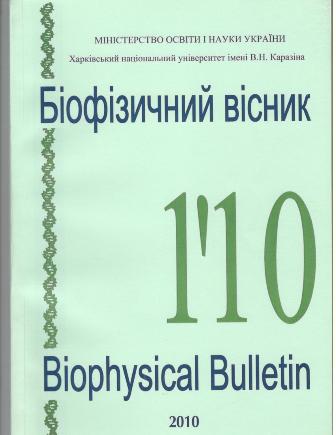Роль процесінгу у вікових змінах термостабільності колагену
Анотація
In vitro вивчено зв'язок між ступенем гідроксилювання пролілу і окислювального дезамінування ε - NH2-груп лізилу та гідроксилізилу в колагені та термостабільністю його надмолекулярних структур в шкірі щурів лінії Wistar у постнатальному онтогенезі. Показано, що підвищуючись до 3- місячного віку, вміст цих вільних ε - NH2-груп в колагені залишається далі постійним, в той час, як вміст вільних COH—груп, починаючи з одного місяця, неухильно знижується з віком. У відповідності з цим міжмолекулярне поперечне зв’язування колагенових надмолекулярних структур знижується у період від 1 до 3 місяців, після чого постійно підвищується до 24 місяців. Вміст гідроксипроліну в колагені безперервно знижується у постнатальному онтогенезі. Сумісна дія обох ефектів призводить до зниження їх термостабільності надмолекулярних колагенових структур в шкірі у період від 1 до 3 місяців з подальшим її ростом до 24 місяців.
Завантаження
Посилання
2. Обысов А.С. Надёжность биологических тканей. – М.; Медицина. – 1971. – 103 с.
3. Vogel M. G. Influence of maturation and ageing on mechanical and biochemical properties of connective tissue in rats // Mech. Ageing and Dev. – 1980. – Vol. 14, № 3. – 4. – P. 283 – 292.
4. Jenkins C.L., Raines R.T. Insights on the conformational stability of collagen // Nat. Prod. Rep. – 2002. – Vol. 19. – P. 49 – 59.
5. Berisio R., Vitagliano L., Mazzarella L., Zagari A. Crystal structure of a collagen-like polypeptide with repeating sequence Pro-Hyp-Gly at 1,4 A resolution: implications for collagen hydration // Biopolymers. – 2000 – 2001. – Vol. 56, № 1. – Р. 8 – 13.
6. Борискина Е.П. Энергии водородных связей, стабилизирующие конформацию гидратированных коллагеновых структур: Дис. канд. физ.-мат. наук. – Харьков.: - Харьковский национальный университет им. В.Н.Каразина. – 2007. – 147 с.
7. Berg R.A., Prockop D.J. The thermal transition of a non-hydroxylated form of collagen. Evidence for a role for hydroxyproline in stabilizing the triple-helix of collagen // Biochem. Biophys. Res. Commun. – 1973. – Vol. 152, № 1. – P. 115 – 120.
8. Nishi Y., Uchiyama S., Nishiuchi Y., Nakazawa T., Ohkubo T., Kobayashi Y. Different effects of 4- hydroxyproline and 4-fluoroproline jn the stability of collagen triple helix // Biochemistry. – 2005. – Vol. 44, № 16. – Р. 6034 – 6042. 9. Eyre D.R., Wu J. – J. Collagen Cross – Links // Topics in Current Chemistry. – 2005. – Vol. 247. – P. 207 – 229.
10. Bailey A.Y., Paul R.G. The mechanisms and consequences of the maturation and ageing of collagen // Proc. Indian Acad. Sci. (Chem. Sci.). – 1999. – Vol. 111, № 1. – P. 57 – 69.
11. Перский Е. Э., Никитина Н.А., Наглов А.В., Кот Ю.Г. Возрастные особенности индукции синтеза и интенсивности некоторых стадий процессинга коллагена в соединительной ткани под действием механической нагрузки // Биологический вестник. – 2006 . – Т.10, № 2. – С. 126 – 129.
12. Yamauchi M., Masashi М. Post-translational Modifications of Proteins: Lysine Hydroxylation and Cross-linking of collagen // Tools for Functional Proteomics. – Series: Methods in Molecular Biology. – 2008. – Vol. 445. P. 95 – 108.
13. И. Клотц. Энергетика биохимических реакций.- М.: Мир.–1970.– 112 с.
14. Гарбузенко О.Б., Емец Е.Б., Перский Е.Э. Влияние деформации на обмен белков и механические свойства аорты и кожи крыс in vitro // Вестн. пробл. биол. и мед. - 1997. - № 25. - С. 12-18.
15. Бейли Дж. Методы химии белков – М.: Мир, 1965. – 284 с.
16. Дубинина Е.Е. Окислительная модификация белков плазмы крови больных с психиатрическими расстройствами // Вопр. мед. химии. – 2000. – №4. – С. 36 – 47.
17. Утевская Л.А., Перский Е.Э. Простой метод определения суммарного и свободного оксипролина // Вестн. Харьк. ун-та. – 1982. – № 226. – С. 18 – 20.
Автори, які публікуються у цьому журналі, погоджуються з наступними умовами:
- Автори залишають за собою право на авторство своєї роботи та передають журналу право першої публікації цієї роботи на умовах ліцензії Creative Commons Attribution License, котра дозволяє іншим особам вільно розповсюджувати опубліковану роботу з обов'язковим посиланням на авторів оригінальної роботи та першу публікацію роботи у цьому журналі.
- Автори мають право укладати самостійні додаткові угоди щодо неексклюзивного розповсюдження роботи у тому вигляді, в якому вона була опублікована цим журналом (наприклад, розміщувати роботу в електронному сховищі установи або публікувати у складі монографії), за умови збереження посилання на першу публікацію роботи у цьому журналі.
- Політика журналу дозволяє і заохочує розміщення авторами в мережі Інтернет (наприклад, у сховищах установ або на особистих веб-сайтах) рукопису роботи, як до подання цього рукопису до редакції, так і під час його редакційного опрацювання, оскільки це сприяє виникненню продуктивної наукової дискусії та позитивно позначається на оперативності та динаміці цитування опублікованої роботи (див. The Effect of Open Access).





